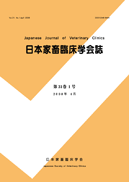Volume 28, Issue 2
Displaying 1-6 of 6 articles from this issue
- |<
- <
- 1
- >
- >|
-
2005Volume 28Issue 2 Pages 33
Published: November 10, 2005
Released on J-STAGE: April 22, 2009
Download PDF (75K) -
2005Volume 28Issue 2 Pages 34-41
Published: November 10, 2005
Released on J-STAGE: April 22, 2009
Download PDF (512K) -
2005Volume 28Issue 2 Pages 42-46
Published: November 10, 2005
Released on J-STAGE: April 22, 2009
Download PDF (361K) -
2005Volume 28Issue 2 Pages 50-58
Published: November 10, 2005
Released on J-STAGE: April 22, 2009
Download PDF (558K) -
2005Volume 28Issue 2 Pages 59-81
Published: November 10, 2005
Released on J-STAGE: April 22, 2009
Download PDF (7610K) -
2005Volume 28Issue 2 Pages 82-83
Published: November 10, 2005
Released on J-STAGE: April 22, 2009
Download PDF (99K)
- |<
- <
- 1
- >
- >|
